Top Four Reasons to Travel to Bordeaux!
December 6, 2024
Bordeaux is well known for being the wine capital of the world, and with good reason. Bordeaux produces at least 400 million liters of -…
Read This Post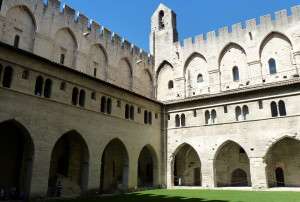 It sometimes surprises travelers that the largest Gothic palace in the world is the Palais des Papes (Palace of the Popes) and that it lies not in Rome, but in Avignon, France!
It sometimes surprises travelers that the largest Gothic palace in the world is the Palais des Papes (Palace of the Popes) and that it lies not in Rome, but in Avignon, France!
It is not only one of the most visited sites in France, it is one of the most popular cultural sites explored by our culinary travelers in Provence. In fact, most of our cooking vacations in Provence include either a visit of the Popes’ Palace or free time to explore it in Avignon on your own.
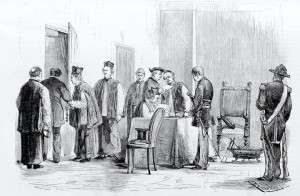 Why Avignon? In 1305 Clement V, a Frenchman, was elected pope largely due to the influence of the French King Phillip IV when the factions of French and Italian cardinals could not find a consensus candidate. His election was not popular in Rome in part because of the especially poor relationship at the time between the papacy and the French king. The Roman clergy accused the French pope of corruption and of being influenced by (or even controlled by) the French king.
Why Avignon? In 1305 Clement V, a Frenchman, was elected pope largely due to the influence of the French King Phillip IV when the factions of French and Italian cardinals could not find a consensus candidate. His election was not popular in Rome in part because of the especially poor relationship at the time between the papacy and the French king. The Roman clergy accused the French pope of corruption and of being influenced by (or even controlled by) the French king.
Clement apparently decided Avignon would be a preferable place to live, whether due to influence by the French court or because he wanted to avoid the infighting taking place between the papal states, and he moved the papacy there in 1309.
Thus began the Avignon Papacy, which lasted until 1378, and whose traces are still seen today in the magnificent palace.
 Among Clement V first acts was to appoint more French cardinals. But since Cardinals elect the next pope, there began a succession of seven straight French popes. The great palace of the Popes was built on the site of an old bishop’s palace, and for the most part under the rule of just two of these Avignonese popes. The popes, Benedict XII and Clement IV, were both reputedly great builders, which might account for the stunning achievement, as the palace as it now stands was mostly built from 1335 to 1352.
Among Clement V first acts was to appoint more French cardinals. But since Cardinals elect the next pope, there began a succession of seven straight French popes. The great palace of the Popes was built on the site of an old bishop’s palace, and for the most part under the rule of just two of these Avignonese popes. The popes, Benedict XII and Clement IV, were both reputedly great builders, which might account for the stunning achievement, as the palace as it now stands was mostly built from 1335 to 1352.
In 1377 Gregory XI, the last official Avignonese pope, was persuaded to move the papacy back to Rome. The French Cardinals were not in agreement with this decision, and when Gregory XI died shortly after the return of the See to Rome, the successor elected in Rome, Urban VI, was so hated by them that in 1378 thirteen of the French Cardinals decided to elect their own pope and install him in Avignon.
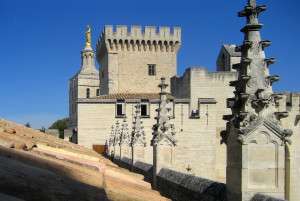 This period of time, in which there was a pope in Rome and another “pope” (or “antipope,” although this term is not specific to the Avignon antipopes) still at the Papal Palace in Avignon, is referred to at the Great Schism (or the Western Schism). It lasted almost four decades, and was only resolved in 1417 when the Council of Constance arranged the abdication of the Roman pope Gregory XII, the abdication of a Pisan Pope that had been elected in 1409 in an attempt to heal the breach (so yes, for several years there were THREE popes), and the excommunication of the Avignon pope Benedict XIII. A new pope, Martin V, was elected and installed in Rome.
This period of time, in which there was a pope in Rome and another “pope” (or “antipope,” although this term is not specific to the Avignon antipopes) still at the Papal Palace in Avignon, is referred to at the Great Schism (or the Western Schism). It lasted almost four decades, and was only resolved in 1417 when the Council of Constance arranged the abdication of the Roman pope Gregory XII, the abdication of a Pisan Pope that had been elected in 1409 in an attempt to heal the breach (so yes, for several years there were THREE popes), and the excommunication of the Avignon pope Benedict XIII. A new pope, Martin V, was elected and installed in Rome.
 The palace is a large, foreboding stone structure with some 15,000 square meters of living space and more than 20 rooms. It is no wonder that it is part of Avignon’s UNESCO World Heritage Site.
The palace is a large, foreboding stone structure with some 15,000 square meters of living space and more than 20 rooms. It is no wonder that it is part of Avignon’s UNESCO World Heritage Site.
As you enter the palace through the impressive Porte des Champeaux, you will see that the palace is built around 2 courtyards, La Cour d’Honneur (or Great Courtyard) and a smaller courtyard.
One side is the Old palace, which was the palace of Benedict XII, and on the other is the New Palace with the Great Chapel and Great Audience room, which was the palace of Clement VI. The entire complex is a huge stone fortress with massive walls and four stone towers at each corner, and must of it is austere stone with little or no decoration.
The papal apartments, including the famed “Chambre du cerf,” or Stag room, are among the most visited of the rooms, with frescoes by the Italian artist Matteo Giovannetti, as is the Great Audience room. There are few furnishings, and these are reproductions, but the with the aid of a virtual tour you can see how many of the rooms would have appeared in the time of the popes.
The Palace contains a breathtaking grand staircase as well as tombs of some of the Popes. It also offers amazing views from its terraces, including of the Rhöne River, the Saint-Bénezet bridge, the Petit Palais, and the Doms Cathedral, which has at its top a golden Madonna statue, one of the visual symbols of Avignon.
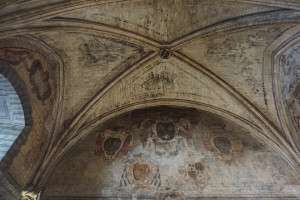 After the papacy finally returned for good to Rome, the palace gradually deteriorated over the centuries that followed. During the French Revolution it was seized by revolutionaries and sacked, and was the site of a massacre of counter-revolutionaries in 1791.
After the papacy finally returned for good to Rome, the palace gradually deteriorated over the centuries that followed. During the French Revolution it was seized by revolutionaries and sacked, and was the site of a massacre of counter-revolutionaries in 1791.
It became a prison and barracks under the Napoleonic state, and was further damaged during this millitary occupation. In paricular during anti-clerical periods the interiors were gutted.
The building became a national museum in 1906 and has bascially been undergoing restoration ever since.
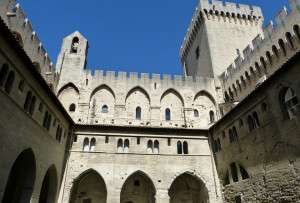 Here is some practical information to help you plan your visit!
Here is some practical information to help you plan your visit!
Please note that currently it is required to have a valid health pass (obtained with proof of vaccination against COVID-19) in order to enter the palace.
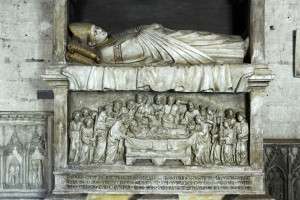 You can visit the Palace of the Popes in Avignon on many of our fabulous Provence cooking vacations, including:
You can visit the Palace of the Popes in Avignon on many of our fabulous Provence cooking vacations, including:
Whether you’re a first time traveler to France or a seasoned veteran, make sure the Palais des Papes is on your next itinerary!
By Peg Kern
Sign up to receive our newsletter, which includes travel tips, recipes, promotions, and information on our best cooking vacations.
Find more photos, videos, food facts, and travel stories from The International Kitchen on Facebook, YouTube, Instagram, Pinterest, and Twitter.